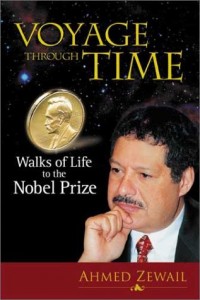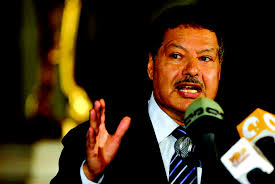By Ahmed Zewail
Early in 1974 we went to Berkeley, excited by the new opportunities. Culturally, moving from Philadelphia to Berkeley was almost as much of a shock as the transition from Alexandria to Philadelphia – Berkeley was a new world! I saw Telegraph Avenue for the first time, and this was sufficient to indicate the difference. I also met many graduate students whose language and behavior I had never seen before, neither in Alexandria, nor in Philadelphia. I interacted well with essentially everybody, and in some cases I guided some graduate students. But I also learned from members of the group. The obstacles did not seem as high as they had when I came to the University of Pennsylvania because culturally and scientifically I was better equipped. Berkeley was a great place for science – the BIG science. In the laboratory, my aim was to utilize the expertise I had gained from my Ph.D. work on the spectroscopy of pairs of molecules, called dimers, and to measure their coherence with the new tools available at Berkeley. Professor Charles Harris was traveling to Holland for an extensive stay, but when he returned to Berkeley we enjoyed discussing science at late hours! His ideas were broad and numerous, and in some cases went beyond the scientific language I was familiar with. Nevertheless, my general direction was established. I immediately saw the importance of the concept of coherence. I decided to tackle the problem, and, in a rather short time, acquired a rigorous theoretical foundation which was new to me. I believe that this transition proved vital in subsequent years of my research.
I wrote two papers with Charles, one theoretical and the other experimental. They were published in Physical Review. These papers were followed by other work, and I extended the concept of coherence to multidimensional systems, publishing my first independently authored paper while at Berkeley. In collaboration with other graduate students, I also published papers on energy transfer in solids. I enjoyed my interactions with the students and professors, and at Berkeley’s popular and well-attended physical chemistry seminars. Charles decided to offer me the IBM Fellowship that was only given to a few in the department. He strongly felt that I should get a job at one of the top universities in America, or at least have the experience of going to the interviews; I am grateful for his belief in me. I only applied to a few places and thought I had no chance at these top universities. During the process, I contacted Egypt, and I also considered the American University in Beirut (AUB). Although I visited some places, nothing was finalized, and I was preparing myself for the return. Meanwhile, I was busy and excited about the new research I was doing. Charles decided to build a picosecond laser, and two of us in the group were involved in this hard and “non-profitable” direction of research (!); I learned a great deal about the principles of lasers and their physics.
During this period, many of the top universities announced new positions, and Charles asked me to apply. I decided to send applications to nearly a dozen places and, at the end, after interviews and enjoyable visits, I was offered an Assistant Professorship at many, including Harvard, Caltech, Chicago, Rice, and Northwestern. My interview at Caltech had gone well, despite the experience of an exhausting two days, visiting each half hour with a different faculty member in chemistry and chemical engineering. The visit was exciting, surprising and memorable. The talks went well and I even received some undeserved praise for style. At one point, I was speaking about what is known as the FVH, picture of coherence, where F stands for Feynman, the famous Caltech physicist and Nobel Laureate. I went to the board to write the name and all of a sudden I was stuck on the spelling. Half way through, I turned to the audience and said, “you know how to spell Feynman”. A big laugh erupted, and the audience thought I was joking – I wasn’t! After receiving several offers, the time had come to make up my mind, but I had not yet heard from Caltech. I called the Head of the Search Committee, now a colleague of mine, and he was lukewarm, encouraging me to accept other offers. However, shortly after this, I was contacted by Caltech with a very attractive offer, asking me to visit with my family. We received the red carpet treatment, and that visit did cost Caltech! I never regretted the decision of accepting the Caltech offer.
My science family came from all over the world, and members were of varied backgrounds, cultures, and abilities. The diversity in this “small world” I worked in daily provided the most stimulating environment, with many challenges and much optimism. Over the years, my research group has had close to 150 graduate students, postdoctoral fellows, and visiting associates. Many of them are now in leading academic, industrial and governmental positions. Working with such minds in a village of science has been the most rewarding experience – Caltech was the right place for me.
My biological children were all “made in America”. I have two daughters, Maha, a Ph.D. student at the University of Texas, Austin, and Amani, a junior at Berkeley, both of whom I am very proud. I met Dema, my wife, by a surprising chance, a fairy tale. In 1988 it was announced that I was a winner of the King Faisal International Prize. In March of 1989, I went to receive the award from Saudi Arabia, and there I met Dema; her father was receiving the same prize in literature. We met in March, got engaged in July and married in September, all of the same year, 1989. Dema has her M.D. from Damascus University, and completed a Master’s degree in Public Health at UCLA. We have two young sons, Nabeel and Hani, and both bring joy and excitement to our life. Dema is a wonderful mother, and is my friend and confidante.
The journey from Egypt to America has been full of surprises. As a Moeid, I was unaware of the Nobel Prize in the way I now see its impact in the West. We used to gather around the TV or read in the newspaper about the recognition of famous Egyptian scientists and writers by the President, and these moments gave me and my friends a real thrill – maybe one day we would be in this position ourselves for achievements in science or literature. Some decades later, when President Mubarak bestowed on me the Order of Merit, first class, and the Grand Collar of the Nile (“Kiladate El Niel“), the highest State honor, it brought these emotional boyhood days back to my memory. I never expected that my portrait, next to the pyramids, would be on a postage stamp or that the school I went to as a boy and the road to Rosetta would be named after me. Certainly, as a youngster in love with science, I had no dreams about the honor of the Nobel Prize.
Since my arrival at Caltech in 1976, our contributions have been recognized by countries around the world. Among the awards and honors are:
Special Honors
King Faisal International Prize in Science (1989).
First Linus Pauling Chair, Caltech (1990).
Wolf Prize in Chemistry (1993).
Order of Merit, first class (Sciences & Arts), from President Mubarak (1995).
Robert A. Welch Award in Chemistry (1997).
Benjamin Franklin Medal, Franklin Institute, USA (1998).
Egypt Postage Stamps, with Portrait (1998); the Fourth Pyramid (1999).
Nobel Prize in Chemistry (1999).
Grand Collar of the Nile, Highest State Honor, conferred by President Mubarak (1999).
Prizes and Awards
Alfred P. Sloan Foundation Fellow (1978-1982).
Camille and Henry Dreyfus Teacher-Scholar Award (1979-1985).
Alexander von Humboldt Award for Senior United States Scientists (1983).
National Science Foundation Award for especially creative research (1984; 1988; 1993).
Buck-Whitney Medal, American Chemical Society (1985).
John Simon Guggenheim Memorial Foundation Fellow (1987).
Harrison Howe Award, American Chemical Society (1989).
Carl Zeiss International Award, Germany (1992).
Earle K. Plyler Prize, American Physical Society (1993).
Medal of the Royal Netherlands Academy of Arts and Sciences, Holland (1993).
Bonner Chemiepreis, Germany (1994).
Herbert P. Broida Prize, American Physical Society (1995).
Leonardo Da Vinci Award of Excellence, France (1995).
Collége de France Medal, France (1995).
Peter Debye Award, American Chemical Society (1996).
National Academy of Sciences Award, Chemical Sciences, USA (1996).
J.G. Kirkwood Medal, Yale University (1996).
Peking University Medal, PU President, Beijing, China (1996).
Pittsburgh Spectroscopy Award (1997).
First E.B. Wilson Award, American Chemical Society (1997).
Linus Pauling Medal Award (1997).
Richard C. Tolman Medal Award (1998).
William H. Nichols Medal Award (1998).
Paul Karrer Gold Medal, University of Zürich, Switzerland (1998).
E.O. Lawrence Award, U.S. Government (1998).
Merski Award, University of Nebraska (1999).
Röntgen Prize, (100th Anniversary of the Discovery of X-rays), Germany (1999).
American Physical Society, Fellow (elected 1982).
National Academy of Sciences, USA (elected 1989).
Third World Academy of Sciences, Italy (elected 1989).
Sigma Xi Society, USA (elected 1992).
American Academy of Arts and Sciences (elected 1993).
Académie Européenne des Sciences, des Arts et des Lettres, France (elected 1994).
American Philosophical Society (elected 1998).
Pontifical Academy of Sciences (elected 1999).
American Academy of Achievement (elected 1999).
Royal Danish Academy of Sciences and Letters (elected 2000)
Honorary Degrees
Oxford University, UK (1991): M.A., h.c.
American University, Cairo, Egypt (1993): D.Sc., h.c.
Katholieke Universiteit, Leuven, Belgium (1997): D.Sc., h.c.
University of Pennsylvania, USA (1997): D.Sc., h.c.
Université de Lausanne, Switzerland (1997): D.Sc., h.c.
Swinburne University, Australia (1999): D.U., h.c.
Arab Academy for Science & Technology, Egypt (1999): H.D.A.Sc.
Alexandria University, Egypt (1999): H.D.Sc.
University of New Brunswick, Canada (2000): Doctoris in Scientia, D.Sc., h.c.
Universita di Roma “La Sapienza”, Italy (2000): D.Sc., h.c.
Université de Liège, Belgium (2000): Doctor honoris causa, D., h.c.
From Les Prix Nobel. The Nobel Prizes 1999, Editor Tore Frängsmyr, [Nobel Foundation], Stockholm, 2000
—————
Source:
MLA style: “Ahmed Zewail – Biographical“. Nobelprize.org. Nobel Media AB 2013. Web. 2 May 2014. www.nobelprize.org


